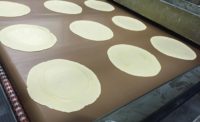The word indulgence is often used in any discussion of cookies. And while that still holds true, more better-for-you, healthy options are hitting the shelves. But regardless of the protein levels in cookies, consumers are still looking for treats with appealing flavor combinations that taste good and offer a multi-dimensional bite.
Overview | Bread | Tortillas | Sweet Goods | Snack Cakes | Pizza | Desserts | Cookies | Buns & Rolls | Bars | Breakfast Products
Market data
Looking at sales data from IRI, Chicago, for the 52 weeks ending March 25, 2018, dollar sales of cookies were up 2.7 percent, accounting for $8.5 billion. Private label saw notable growth, rising 10.06 percent in dollar sales to $1.4 billion. Pepperidge Farm also performed well, up 4.88 percent to $409.4 million. Category leader Mondelez International and its core Nabisco business was relatively flat, up 0.88 percent to $3.2 billion.
Better-for-you cookie specialist Lenny & Larry’s saw a significant uptick for the year, up 44.26 percent to $111.4 million. The Mondelez/Nabisco brand belVita continued its pattern of strong sales, up 14.49 percent to $350.1 million. General Mills bar brand Nature Valley is also making inroads to the cookies category with its hybrid lines, up 32.76 percent to $90.7 million.
The overall refrigerated dough category was up 1.14 percent to $1.8 billion, and refrigerated cookie/brownie dough outpaced all other segments, up 4.08 percent to $512.8 million. Segment brand leader Nestlé Tollhouse was relatively flat, down 0.05 percent to $168.4 million. RTE cookie dough specialist The Cookie Dough Café had a strong year, up 314.78 percent to $8.5 million. Organic also performed well, with the General Mills Annie’s Homegrown cookie dough up 30.49 percent to $5.4 million.
Frozen cookies fared well for the reporting period, up 73.68 percent to $7.4 million. Private label is pacing the category, up 85.57 percent to $2.5 million, while The French Patisserie and its Looka macaron brand was up 4.19 percent to $1.9 million.
Frozen cookie dough largely had an off year, down 51.84 percent to $5.6 million. Of the top five companies in the segment, only RubySnap saw a gain, up 38.29 percent to $752,325.
Looking back
During the past year, more cookie producers have varied their lineups by creating different shapes and designs using customized drums or dies. The market also has experienced diversification, with new entrants looking to differentiate themselves and more activity among small-volume producers.
Most cookies are positioned as an indulgent snack, with new formats that appeal to the on-the-go consumer, according to Cassandra Edwards, senior manager marketing communications and customer engagement, snacks, Kerry, Beloit, WI. LTOs, including seasonal offerings, continue to be successful in creating new flavor combinations that keep drawing consumers’ interest back into the category.
“Indulgence also is playing a role in converting the typical protein bar consumer into a cookie consumer. There has been a lot of focus on taste in protein cookie innovations and launches in the past year to help otherwise healthy consumers experience a sense of permissible indulgence,” Edwards notes.
The standard baked, store-bought cookie will always be the go-to cookie product, according to Sam Pallottini, director, cookie, cracker, pet food equipment sales, Reading Bakery Systems, Robesonia, PA. “However, the gourmet style, baked-at-point-of-sale cookie category continues to grow. These cookies are made with higher butter, fat and inclusions that provides a warm, chewy center. Consumers are willing to pay more for these high-indulgent products.” Reading Bakery Systems offers an efficient frozen dough machine with strong sanitary design that forms cookies and places them on paper to go through a freezer.
Craig Kominiak, sales consultant, Erika Record Baking Equipment, Clifton, NJ, says most of his company’s clients are seeking solutions that address their unique dough offerings. Typically this involves cookie products that are full of inclusions like nuts, chocolate chips or chunks, and berries. These clients are looking for a clean, uniform deposit, which keeps product breakdown to a minimum.
“We routinely encounter clients who are experimenting with new flavors, different inclusions and alternative ingredients. This includes unique flavor mash-ups or products that address a particular health concern—for example low-carbohydrate or gluten-free,” says Kominiak.
Kominiak has also seen cookie products infused with candies such as M&M’s and KitKat pieces. On the other end of the spectrum, he is also seeing products that incorporate some sort of natural supplement that promotes a healthy cookie image. The company’s Formatic machine helps cookie producers handle these various inclusions and particulates. It allows cookies producers to create a large assortment of flavor combinations.
The number of small, niche cookie producers is growing, according to John McIsaac, vice president of strategic business development, Reiser, Canton, MA. The challenge for the small producer is to move from manual production to more-automated production—while still maintaining the look and quality of the product that has fueled the company’s growth. “Advances in Vemag double-screws allow the machine to process a variety of doughs and inclusions with great identity and weight control,” he says.
Single-serve options offer the convenience and portion-control that consumers are looking for when reaching for a snack—placing cookies back into their mindset as a go-to snack as opposed to just a dessert, according to Joel Warady, general manager and chief sales and marketing officer, Enjoy Life Foods, Chicago, a Mondelez business unit focused on free-from product development and the 2017 “Bakery of the Year” from Snack Food & Wholesale Bakery. He points to research by Neilsen that shows 98 percent of U.S. households purchase single-serve, grab-and-go snack products annually.
“That’s why we introduced our line of Mini Cookies that are conveniently portioned in six one-ounce snack packs per box,” says Warady. “We offer seven flavors—ranging from traditional chocolate chip to fan-favorite Snickerdoodle—with crunchy and soft-baked options.”
Looking Forward
Cookie growth has slowed from previous years as the category faces competition from confections and bars, according to Edwards. She sees the greatest opportunity for growth in continuing to position cookies as a treat—but with slight better-for-you spins—to capture consumer snacking occasions. “To combat the negative image of sugar, cookie producers may look to create more bite-size options to give consumers a better sense of permissible indulgence and create an easy, on-the-go treating option for today’s busy lifestyles.”
Pallottini says the cookie category’s greatest opportunity for growth lies in diversification. “The next steps are to develop cookies that have a different mouthfeel and texture. Consumers are looking for new products that offer a multi-dimensional bite.” This could open the door for cookie companies to develop two-dough, filled or co-extruded cookies to fuel demand. The product type showing the biggest potential for growth is frosted cookies, he adds.
Warady sees opportunities to introduce cookies to other parts of the day. “We are seeing more consumers look for on-the-go solutions offered by breakfast cookies as this category continues to grow. We also see opportunities in the decadent dessert category, and innovation in dessert cookies. Cookies are no longer simply focused on children; more adults are consuming them as meal replacements.”
The future of the cookie category also depends on the ingredients being used, according to Warady, who predicts the growth of clean label—but with the addition of nutritional ingredients, such as probiotics and protein. Third-party certifications also are here to stay, including non-GMO, gluten-free, vegan, kosher and halal.
“The challenge will remain finding the best alternative ingredients that taste better than ever,” says Warady. “That’s why we’ve invested in sophisticated equipment and R&D teams to continue innovating first-to-market options that stay true to our free-from commitment.”
Overview | Bread | Tortillas | Sweet Goods | Snack Cakes | Pizza | Desserts | Cookies | Buns & Rolls | Bars | Breakfast Products










